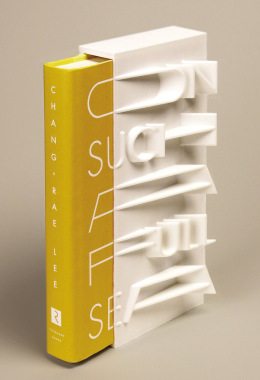Ok, perhaps there IS a commercial use for PRINT and 3D Printers after all! Thanks to Gary Jones from PIA for sharing this in my LinkedIn Group!
Check It Out: The First-Ever 3D-Printed Book Cover
The limited edition of ‘On Such a Full Sea’ brings publishing into the future (or, rather, one possible future) By Lily Rothman @lilyrothman
 Everybody knows what a book looks like. Even as e-books become more popular, the basic idea is the same as it’s been for centuries: a rectangular block. And Chang-rae Lee’s On Such a Full Sea is no exception—on the inside, at least. On the outside, however, the novel is something entirely new.
Everybody knows what a book looks like. Even as e-books become more popular, the basic idea is the same as it’s been for centuries: a rectangular block. And Chang-rae Lee’s On Such a Full Sea is no exception—on the inside, at least. On the outside, however, the novel is something entirely new.
The book will be available Jan. 7 in limited edition with what the publisher, Riverhead Books, is calling the first-ever 3D-printed slipcover, the result of a collaboration with the 3D-printing mavens at Makerbot. The white slipcover, into which the book fits neatly, features the letters of the title rising off the surface at an angle, and the idea all along was to do something unlike anything ever seen in the world of publishing, Riverhead’s art director, Helen Yentus, tells TIME: “I didn’t even think we’d be able to do it, because it’s such a new and innovative technology.”
In the end, each individual slip cover took 15 hours to print. Some test prototypes took up to 30 hours. Yentus has been a book-cover designer for more than 10 years and is used to being able to sketch any flat design and immediately see the idea on paper, but she had to learn from scratch what the printer technology was capable of doing. (One trick, she admits with a laugh, was asking her designer father to show her how to use AutoCAD to see what her ideas might look like.) The finished design was made for a special-edition run of 200 signed copies for sale—a number partially decided by how many could physically be printed in time for the shelf date.
Read more: First 3D Printed Book Slipcover ‘On Such a Full Sea’ | TIME.com http://entertainment.time.com/2014/01/06/check-it-out-the-first-ever-3d-printed-book-cover/#ixzz2pjZdfJre












4 Responses
Let’s see. A web press can do 50,000 12-up sheets per hour, which is 600,000 covers/hour.
Using the faster 3D printing speed, 15 hrs per cover, which is 0.067 covers/hour. 3D printing needs to speed up by only a factor of 900 million to catch up.
I did a small 3D side project. I used the extremely user friendly Cubify software. Still, this is very far from a manufacturing process. It’s good for making a prototype so that a high volume injection mold can made.
Otherwise it’s missing the production part. A solution in search of a problem. It would be like using Chromalins for volume production.
Here’s my idea. Digital presses are faster than older ink-jet printers because they print a line (1-D) at a time rather than having a moving print head be at a specific point at a time (zero-D). A viable 3D printer should at least do the same, print a line of resin at a time. When someone figures a way to bump it up another dimension, 2-D at a time then we might get close. 2-D at a time works for stamping vinyl, CDs, DVDs, and even making printing plates from film.
Even though you write the first one slowly, afterwards you rise above it all and print from a “higher plane”.
Might as well give it an esoteric name – how about the Printerversal Principle.
Mitch Bogart Great comment! Loving the Printerverse Principle too! Will work that in to the repertoire!
I am very
glad to learn alot from you this meaningful knowledge. From an article
describing your unique way , we can see that you are an approachable ,
humorous person
I am not sure it is the first-ever 3D printed book. In october 2013, The National library of the Netherlands did a binding book with a 3D printer.
http://nouvelles-graphiques.levif.be/fr/actualite/une-bibliotheque-hollandaise-relie-un-livre-avec-une-imprimante-3d/article-4000423178797.htm
http://www.graficus.nl/nieuws/17609-handboekbinden-meets-3d.html